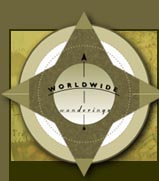|
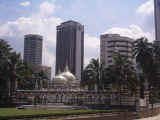 July 4-6, 1999
Kuala Lumpur, Malaysia July 4-6, 1999
Kuala Lumpur, Malaysia"Yes, O.K., get off now. Bus
station more that way" the driver tells us as we (the last ones off the coach, but
seeing no choice but to follow the rest of the passengers) pass by his seat with what must
have been a set of obviously bewildered blank stares on our faces. 'We're clearly NOT in
Australia anymore Toto' I think to myself as we schlep along the crowded 'sidewalk',
alongside 20 or so rumbling, hot-exhaust-spewing buses on our way to the station. Turns
out, it's faster to walk than ride, as all the busses are now basically stopped in a
gridlock of afternoon traffic - well duh you silly Westerners, everyone else seemed to
know that!.
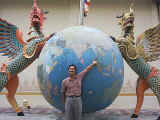 "Yep, we're definitely back in
Asia" I mumble to myself (halfway laughing, and loud enough so Laura can hear) as we
bump, knock, and push our way through the hoards of other people cramming themselves into
the bus terminal on this humid Sunday afternoon. It's perfect, just perfect. This crowded
station, with its overload of order-filled chaos, is a perfect example, the absolute
embodiment, of what an Asian city means to me. It's about human contact - the literal
kind, being bumped, pushed, and shoved. It's about lots of people, very often in your
'space' (a concept, by the way, that's totally unknown to most Asians), going about
getting where they need to be, and accomplishing what they need to accomplish, all with a
system and purpose that remains somehow elusively hidden to the outside observer. "Yep, we're definitely back in
Asia" I mumble to myself (halfway laughing, and loud enough so Laura can hear) as we
bump, knock, and push our way through the hoards of other people cramming themselves into
the bus terminal on this humid Sunday afternoon. It's perfect, just perfect. This crowded
station, with its overload of order-filled chaos, is a perfect example, the absolute
embodiment, of what an Asian city means to me. It's about human contact - the literal
kind, being bumped, pushed, and shoved. It's about lots of people, very often in your
'space' (a concept, by the way, that's totally unknown to most Asians), going about
getting where they need to be, and accomplishing what they need to accomplish, all with a
system and purpose that remains somehow elusively hidden to the outside observer.
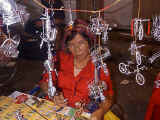 This is Southeast Asia. The Asia that's found in the
humidity-filled breezes that rustle constantly through the flopping palm tree leaves. Her
cities, like Kuala Lumpur, wrapped in the almost constant orchestra of horns that work too
well, and mufflers that barely work at all; and blanketed with a mass of buzzing scooters,
most of their riders, as if by regional law, zipping here and there with their jackets on
backwards. And oh, the smells, the smells! So many of them, almost more than my nose can
handle. This one and that one, or that one and this one, just mixing together, creating a
whole new (and sometimes nauseating) set of 'fragrances of the city'. Mmmm, I think this
one's 'Ode de diesel exhaust with a hint of burning chicken fat'. This is Southeast Asia. The Asia that's found in the
humidity-filled breezes that rustle constantly through the flopping palm tree leaves. Her
cities, like Kuala Lumpur, wrapped in the almost constant orchestra of horns that work too
well, and mufflers that barely work at all; and blanketed with a mass of buzzing scooters,
most of their riders, as if by regional law, zipping here and there with their jackets on
backwards. And oh, the smells, the smells! So many of them, almost more than my nose can
handle. This one and that one, or that one and this one, just mixing together, creating a
whole new (and sometimes nauseating) set of 'fragrances of the city'. Mmmm, I think this
one's 'Ode de diesel exhaust with a hint of burning chicken fat'.
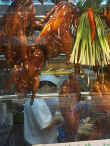 Or maybe it's not chicken, but burning duck or goose. Could be any
of the three. It's sort of hard to tell, because around here they all get the same
treatment. After being plucked and gutted, the birds are cooked whole, head and all, and
then prominently displayed on hooks in the restaurant's windows. Chickens, ducks, geese,
and of course seafood, all proudly served with the staple food of the Asians: rice and
noodles. Rice and noodles, rice and noodles, everywhere - for lunch, dinner, even
breakfast. And not only in the restaurants, but also from the other, arguably more popular
and certainly more convenient, way to dine - the many food carts and hawker stalls. These
make-shift kitchens line a few designated streets, and squeeze tightly into any available
nook or cranny of many others. Or maybe it's not chicken, but burning duck or goose. Could be any
of the three. It's sort of hard to tell, because around here they all get the same
treatment. After being plucked and gutted, the birds are cooked whole, head and all, and
then prominently displayed on hooks in the restaurant's windows. Chickens, ducks, geese,
and of course seafood, all proudly served with the staple food of the Asians: rice and
noodles. Rice and noodles, rice and noodles, everywhere - for lunch, dinner, even
breakfast. And not only in the restaurants, but also from the other, arguably more popular
and certainly more convenient, way to dine - the many food carts and hawker stalls. These
make-shift kitchens line a few designated streets, and squeeze tightly into any available
nook or cranny of many others.
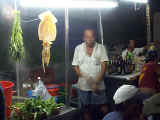 Yep,
being back in Asia means 'window shopping' at hawker stalls before, and then fiddling with
our chopsticks during, (for the first few times until we get comfortable with them again)
our street-side meals. It means struggling to order from menus that are completely in
hand-written kanji symbols. It also means trying new foods, many with names that we've
never heard, and sampling new juices, often freshly squeezed, from fruits that we've never
seen. In addition, it means once again being constantly surrounded by the sounds of
strange languages, as well as the sights of what appear to us as peculiar customs. Yep,
being back in Asia means 'window shopping' at hawker stalls before, and then fiddling with
our chopsticks during, (for the first few times until we get comfortable with them again)
our street-side meals. It means struggling to order from menus that are completely in
hand-written kanji symbols. It also means trying new foods, many with names that we've
never heard, and sampling new juices, often freshly squeezed, from fruits that we've never
seen. In addition, it means once again being constantly surrounded by the sounds of
strange languages, as well as the sights of what appear to us as peculiar customs.
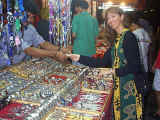 Sights
like locals drinking their soda or juice from a little plastic bag with a straw popping
out of its top (we've come to find out that this method is especially handy for not only
scooter drivers, but also the hawkers in the merchandise stalls, as they can hang the bag
chest-high on a pole and sip an occasional drink, while still keeping both hands free to
fold shirts, make change, etc.). Or the merchants' practice of always using a calculator
as a negotiating tool by tapping a few digits into it, multiplying by this or that, and
then finally spinning it around to show you that "I give you special price, O.K.?
This price good price." Sights
like locals drinking their soda or juice from a little plastic bag with a straw popping
out of its top (we've come to find out that this method is especially handy for not only
scooter drivers, but also the hawkers in the merchandise stalls, as they can hang the bag
chest-high on a pole and sip an occasional drink, while still keeping both hands free to
fold shirts, make change, etc.). Or the merchants' practice of always using a calculator
as a negotiating tool by tapping a few digits into it, multiplying by this or that, and
then finally spinning it around to show you that "I give you special price, O.K.?
This price good price."
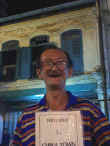 Ahh, the language of negotiation. A good
deal of the time, the tools are from Japan, but the lingo is from America. This does well
to explain why a good many of the people across Southeast Asia, especially those involved
in the hospitality or related tourist trades, speak at least some English. Although many
we meet in the streets don't really understand the word's real meanings, they know how to
make the sounds, and are absolutely thrilled when we validate their effort by answering
back to a 'hello, good day' with a 'hello, good day to you too'. As a rule, the Southeast
Asians, and especially those in Malaysia, try very hard to be friendly to visitors and
will make an effort to converse with us if given the chance. Ahh, the language of negotiation. A good
deal of the time, the tools are from Japan, but the lingo is from America. This does well
to explain why a good many of the people across Southeast Asia, especially those involved
in the hospitality or related tourist trades, speak at least some English. Although many
we meet in the streets don't really understand the word's real meanings, they know how to
make the sounds, and are absolutely thrilled when we validate their effort by answering
back to a 'hello, good day' with a 'hello, good day to you too'. As a rule, the Southeast
Asians, and especially those in Malaysia, try very hard to be friendly to visitors and
will make an effort to converse with us if given the chance.
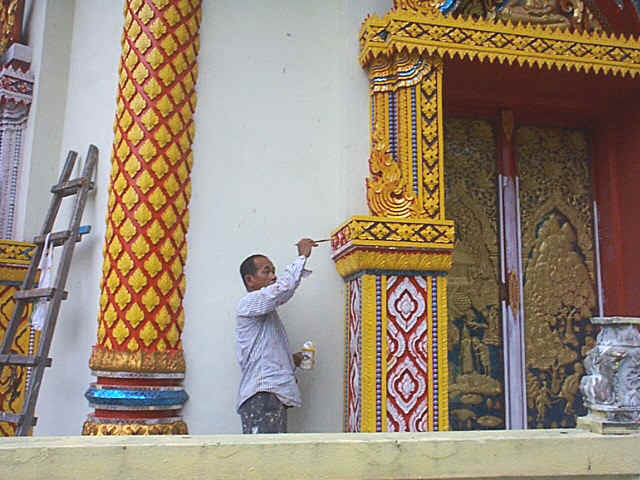 It's
during one of these casual conversations, on an elevator in fact, that we're reminded how
lucky we are to have been born where we were. "America is a great country, with many
great leaders. I name my son after one of your Presidents, John F. Kennedy" explains
an Indian businessman that we're chatting with on our way down to the hotel's lobby. I
guess he's right. For all the problems that we have in the good ol' U.S. of A., we're
still pretty lucky. And at the risk of sounding like a 'cocky American', I do have to
admit, it makes me proud to say that I'm from a country that does a few things 'right'
every now and then. It's
during one of these casual conversations, on an elevator in fact, that we're reminded how
lucky we are to have been born where we were. "America is a great country, with many
great leaders. I name my son after one of your Presidents, John F. Kennedy" explains
an Indian businessman that we're chatting with on our way down to the hotel's lobby. I
guess he's right. For all the problems that we have in the good ol' U.S. of A., we're
still pretty lucky. And at the risk of sounding like a 'cocky American', I do have to
admit, it makes me proud to say that I'm from a country that does a few things 'right'
every now and then.
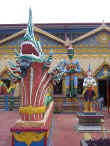 They
must be the 'right' things, for more times than not, they're the principles that we share
and have in common with the most successful of the other countries around the globe. The
'all men are created equal', or 'freedom of religion' thing for instance. America
welcomes, and in fact, in our early days even encouraged, immigration from a host of the
world's sovereign states. We also make it a point to protect their views and beliefs
once they reach our shores. Malaysia takes the same stance, resulting in an interesting
melting pot of various races, creeds, and religions, all living together in relative
harmony. And sometimes, this mixing shows itself through some amusing sights. For example,
the dashboard of the cab we're in is lined with a host of seemingly disparate little
characters. There's a Hindu Ganish, a half dozen Buddhist Buddhas, a Christian Santa
Clause, and slightly out of place Bugs Bunny all staring back at Laura and I. They
must be the 'right' things, for more times than not, they're the principles that we share
and have in common with the most successful of the other countries around the globe. The
'all men are created equal', or 'freedom of religion' thing for instance. America
welcomes, and in fact, in our early days even encouraged, immigration from a host of the
world's sovereign states. We also make it a point to protect their views and beliefs
once they reach our shores. Malaysia takes the same stance, resulting in an interesting
melting pot of various races, creeds, and religions, all living together in relative
harmony. And sometimes, this mixing shows itself through some amusing sights. For example,
the dashboard of the cab we're in is lined with a host of seemingly disparate little
characters. There's a Hindu Ganish, a half dozen Buddhist Buddhas, a Christian Santa
Clause, and slightly out of place Bugs Bunny all staring back at Laura and I.
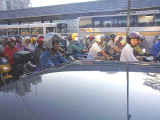 Unfortunately, it doesn't appear that paying homage to any of these
deities is going to be enough to help us through this scooter-congested traffic jam. As we
sit here, barely inching our way forward, with our cabbie pounding his horn to the
seemingly deaf ears around us, I mumble to myself (halfway laughing, and loud enough so
Laura can hear) "yep, we're definitely back in Asia." Unfortunately, it doesn't appear that paying homage to any of these
deities is going to be enough to help us through this scooter-congested traffic jam. As we
sit here, barely inching our way forward, with our cabbie pounding his horn to the
seemingly deaf ears around us, I mumble to myself (halfway laughing, and loud enough so
Laura can hear) "yep, we're definitely back in Asia."
|
